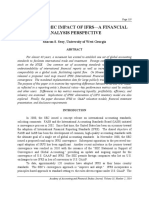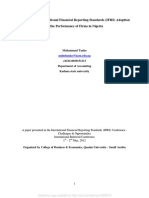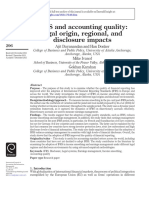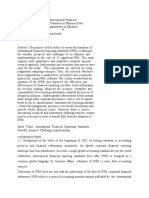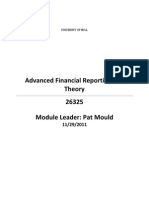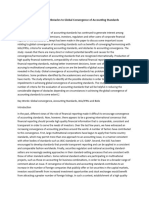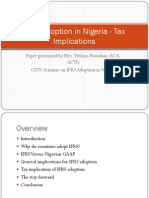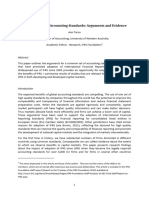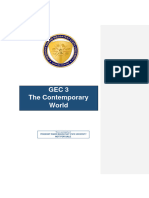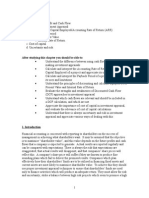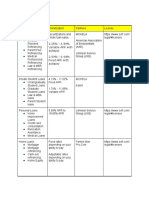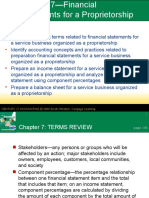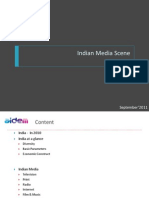Working Papers: Issue 4 - May 2014
Working Papers: Issue 4 - May 2014
Uploaded by
Tiara Eka Putri IskandarCopyright:
Available Formats
Working Papers: Issue 4 - May 2014
Working Papers: Issue 4 - May 2014
Uploaded by
Tiara Eka Putri IskandarOriginal Description:
Original Title
Copyright
Available Formats
Share this document
Did you find this document useful?
Is this content inappropriate?
Copyright:
Available Formats
Working Papers: Issue 4 - May 2014
Working Papers: Issue 4 - May 2014
Uploaded by
Tiara Eka Putri IskandarCopyright:
Available Formats
IBSS Working Papers - Issue 4 May 2014
Working Papers
Issue 4 May 2014
Research Articles
News and Conferences
IFRS impact on Accounting Quality in
Telecommunications Industry
Yusuf Mohammed Nulla
How Do Risk Attitudes of Clearing Firms
Matter for Managing Default Exposure in
Futures Markets?
Jie Cheng, Yi Hong and Juan Tao
Editors:
Reviewers:
Dr Dieu Hack-Polay
Dr Peng Cheng
Dr Brian Wright, Accounting & Finance
Dr Jose Grisolia, Economics
Dr Yue Jiang, Economics
Dr Woonkian Chong, Management
Dr Douglas Davies, Management
Dr Jari Kappi, Accounting & Finance
Dr Yan Sun, Management
Dr Dieu Hack-Polay, Management
Dr Peng Cheng, Accounting & Finance
Dr Ahmet Goncu, Financial Mathematics
Ibss.xjtlu.edu.cn
To publicize your conference or
event here email the editors:
Dieu.hack-polay@xjtlu.edu.cn Or
Peng.cheng@xjtlu.edu.cn
Dr Yafang Wang, Financial Mathematics
Dr Jie Cheng, Financial Mathematics
Ms Kirsty Mattinson, International Recruitment
Dr Simon Rudkin, Economics
IBSS Working Papers - Issue 4 May 2014
About the IBSS Working Papers
The Working Papers series is being launched as the first outlet for emerging publication. It accepts
papers from both internal members of the academic staff and external submissions. The Working
Papers at International Business School Suzhou (IBSS) publishes quality research in progress as well
as critical literature reviews and field notes. To ensure the quality of our published articles, we have
in place an editorial board similar to standard academic journals. This comprises reviewers from a
number of subject groups within IBSS but also from other Schools such as Financial Mathematics,
Language Centre. We welcome reviewers from more schools and if you are interested in being part
of this exciting and challenging initiative, please contact us.
CALL FOR PAPERS
We invite submissions from all areas of Business, Economics, Accounting, Finance and Management.
Papers could be research in progress, monographs in progress, completed research not yet
published, reports and case studies. The maximum length is 8000 words. Theoretical analyses are
also welcome. Submit your papers to dieu.hack-polay@xjtlu.edu.cn or peng.cheng@xjtlu.edu.cn in
order to be considered for the fourth issue.
For Issue 5, we strongly encourage practice-based papers and analyses.
IBSS Working Papers - Issue 4 May 2014
IFRS impact on Accounting Quality in Telecommunications Industry
Yusuf Mohammed Nulla*
ABSTRACT
Globally, the use of the IFRS in financial reporting is the requirement in many countries. However,
the question of whether such a global transition towards a single set of accounting standards has
been met by the presumed benefits of higher accounting quality and comparability yet remains
unanswered. This paper primarily examines the effect of the mandatory IFRS adoption in Canada by
the Canadian telecommunication companies. Since this research is an empirical study, this research
has adopted quantitative research method. That is, by conducting survey, it has collected archival
data from the eight large telecommunication companies of Toronto Stock Exchange (TSX/S&P) index.
It was a comparative study between the Canadian GAAP financial reporting from 2008 to 2010 and
IFRS financial reporting from 2011 to 2012. The research question of this research study is: Does IFRS
adoption in the Canadian financial institutions improve financial reporting quality? This research
finds that the adoption of the IFRS in telecommunication companies have resulted in lower
persistency and predictability in earnings; increase in earnings influence to shareholder value;
negative volatility in market price; better predictability of cash flow and financial forecasts; decrease
in accruals and timeliness loss of recognition; increase in fair market valuation; significant increase in
value relevance; increase in valuation usefulness of earnings to BVPS; and increase in operating
capability and predictability.
Keywords: IFRS, GAAP, accounting quality, financial reporting, organizational performance, income
smoothing, accruals, predictability, reporting aggressiveness, and timeliness loss recognition
*Yusuf Mohammed Nulla
UGSM-Monarch Business School, Switzerland
ymnulla@gmail.com
IBSS Working Papers - Issue 4 May 2014
1. INTRODUCTION
Over the past decade, the International Financial Reporting Standards (IFRS) has emerged as the
dominant reference for financial reporting in most countries around the world, perhaps due to the
influence of investors/shareholders demand, cost minimization in financial reporting, security listings
requirements, foreign investments, free trade, and global competition. In the case of the United States,
the home of the leading global stock indexes, NYSE and NASDAQ, the Securities and Exchange
Commission has publicly expressed its interest or in transition towards adopting the IFRS from the
U.S. GAAP. While there is an extensive research worldwide on the impact of adopting IFRS, I
believe that examining the adoption of the IFRS in the Canadian telecommunications industry
companies since 2011, as one of the largest and influential sectors of the Canadian economy, may
provide relevant information in terms of the nature and extent of the impact on the quality of financial
reporting, which could also be used as a relevant benchmark to predict on other Canadian industries
quality of financial reporting. It is also believed that this research study results will provide relevant
information to the United States accounting scholars and standard setter such as FASB, as both
countries GAAPs are comparable and the respective capital markets are similar in nature. That is,
research findings will provide some useful hints as to what the U.S. firms and markets will expect
from the adoption of the IFRS. From 2011, the Canadian public companies are required to report the
financial information using the International Financial Reporting Standards (IFRS) as mentioned
earlier, a change of reporting culture from the Canadian GAAP. For two decades, Canadas
accounting standard setter has a convergence policy towards the U.S. GAAP, primarily adopting the
U.S. standards with some modification or reconciliation, primarily in the culture of rule-based
standard, a stringent application of accounting regulations. The purpose of this preliminary empirical
research on the IFRS, primarily characterized as principal-based standard (difficult to circumvent
provision in the form of transaction), in Canada, to investigate whether the adoption of the IFRS by
the Canadian telecommunication companies enhances accounting reporting quality. To examine this
important quest, as demanded each time the IFRS is implemented in respective countries; this
research has pursued a comparative approach. That is, first, it study the pre-IFRS period (2008-2010)
under the Canadian GAAP and then compared with the IFRS period (2011-2012), to understand the
nature of the accounting quality, along the defined accounting quality attributes of the reported
earnings, accruals, persistency, value relevance, predictability, income smoothing, timeliness loss of
recognition, and reporting aggressiveness. Previous studies concerning the European countries have
shown an overall increase in earnings management in the post-adoption period, documented by an
increase in income smoothing and no significant change in managing earnings towards a target. The
findings deriving from the measurement of timely loss recognition indicate that the IFRS adoption is
4
IBSS Working Papers - Issue 4 May 2014
associated with a decrease in the timeliness of the recognition of large losses and with a
contemporaneous increase in the timeliness in recognizing economic losses relative to gains in the
reported income. As for the value relevance tests, results highlighted that the IFRS adoption increases
the combined value relevance of the book value and earnings in particular, outcomes of relative value
relevance analysis highlighted that earnings markedly improve its ability to explain stock prices in the
post-adoption period compared to the pre-adoption one (Paglietti, P. 2009).
It is evident that the financial reporting presentation under the IFRS is much more detailed in nature
relative to the Canadian GAAP (despite similar principle-based framework as IFRS) and the United
States GAAP (rule-based framework). That is, under the IFRS, statement of operations items are
detailed in nature such as amortization, purchases of materials, transportation costs, employee
benefits, advertising costs, cost of sales, and cost of distribution. It is theoretically believed that the
adoption of the IFRS is associated with the earnings becoming timelier, more volatile and more
informative, making their introduction beneficial for investors and shareholders. The two most
frequently claimed benefits associated with IFRS adoption are an increase in information quality, and
an increase in accounting comparability. The highest quality standard indicates a standard that either
reduces managerial discretion over accounting choices that are inherently disallowed smoothing or
overstatement of earnings. According to Ball (2006) and Choi and Meek (2005), IFRS has the
potential to facilitate cross-border comparisons, increase reporting transparency, decrease information
costs, reduce information asymmetry and thereby increase the liquidity, competitiveness and
efficiency of the markets.
The properties of the accounting numbers such as earnings smoothness and magnitude of
accruals are affected not only by the underlying economic determinants and the exercise of the
managerial judgments but also by the nature of the accounting standards. For example, the IFRS
permits capitalizing development expenditures that were expensed under many domestic accounting
standards. This has the effect on increasing earnings and reducing earnings volatility. Similarly, IFRS
requires goodwill impairment rather than systematic amortization. Again, this would increase accruals
and earnings except during periods when goodwill is impaired. Another example of a potential
significant change in accruals is recognition of employee benefit expenses that were not recognized
prior to the IFRS adoption. This would reduce accruals and earnings but potentially increase
smoothing. The broader point is that the adoption of certain standards could alter the properties of
earnings without necessarily changing the accounting quality. According to Schipper and Vincent
(2003), earnings are important to a firm for the reason that they are used as a summary measure of the
performance of a firm by a large variety of users. Persistency of the earnings is said to be persistent
when they recur over time, or when they are sustainable or permanent. It also refers to the extent to
which an innovation (unexpectedness) in the earnings series causes investors to revise their future
earnings expectations (Boonlert, 2004). Researchers measure the persistency of earnings by looking at
the explanatory power of the past earnings to present earnings. When the past earnings are not
5
IBSS Working Papers - Issue 4 May 2014
associated with the present earnings, the earnings are not persistent or not recurring. Predictability is
defined as the ability of current earnings to predict future earnings and cash flows from operations.
Current and also past earnings are the input to forecasting the future earnings/cash flows. Smoothness
is measured by the amount of variability of the cash flow and the variability of earnings (Leuz et al.,
2003). Smoothness can be seen as a desirable earning attribute as managers use information about
their future income to smooth out momentary fluctuations. This will give more representative reported
earnings, as these earnings contain future information. Value relevance is determined by measuring
the correlation between the income variables (e.g. EPS) and the market price per share. According to
Lang (1991) it is proven that the stock prices can be explained as a multiple of earnings. Market prices
follow earnings, i.e. changes in earnings will affect the market prices. The higher the explanatory
power of the earnings, the more value relevant the earnings are. Since more value relevant earnings
would describe the firms asset price more accurately, earnings are judged to be of high quality when
they are high value relevant. Warfield and Wild (1992) suggests that the market returns should lead
annual earnings and have a predictive power over the investors. If earnings have a greater predictive
power under IFRS they should be anticipated much more before the release of the annual report under
IFRS than under Canadian GAAP.
2. LITERATURE REVIEW
2.1 Quality of Earnings in IFRS reporting
According to Penman (2002), who stated that, the quality of the earnings is based on the earnings
persistency, predictive ability of the earnings. They view that earnings are to be of high quality when
the firms past earnings are strongly associated with its future earnings. Other researchers view
earnings to be of higher quality when earnings are value relevant, for example, the earnings are
strongly associated with the security's price (Francis and Schipper, 1999). Voulgaris, Stathopoulos,
and Walker (2011) believed that IFRS adds noise to accounting numbers that makes reported earnings
less useful for evaluating managerial performance. This is mainly due to the adoption of the fair value
accounting, which potentially makes accounting numbers more value-relevant, but also more volatile
and sensitive to market movements. In addition, they believed that whilst the IFRS may have made
accounting earnings more useful for stock market valuation purposes, this may have been achieved at
the expense of other purposes that accounting serves, i.e., stewardship/performance contracting. In
other words as accounting numbers are designed to conform more and more closely with market
values, then the less they are able to provide information over what is complementary to market
values for evaluating performance. Similarly, Kim and Suh (1993) believed that if accounting
numbers become more sensitive to market movements than the accounting related signals, provides
6
IBSS Working Papers - Issue 4 May 2014
little additional information about managing performance, as they no longer screen out market related
noise. Moreover, the move to fair value accounting makes accounting earnings figures more volatile
(Barth et al. 2011). If the increase in earnings volatility is driven by events almost entirely outside the
control of management then this also reduces the attractiveness of the earnings, as a basis for
performance-based contracts. Ball (2006) and Choi and Meek (2005) believed that the IFRS has the
potential to facilitate cross border comparability, increase reporting transparency, decrease
information costs, reduce information asymmetry and thereby increase the liquidity, competition and
efficiency of markets. In addition, Ball (2006) notes that the fair value orientation of the IFRS could
add volatility to the financial statements, in the form of both good and bad information, the latter
consisting of noise which arises from inherent estimation error and possible managerial manipulation.
Ahmed, Neel, and Wang (2012) states that, the effects of the mandatory IFRS adoption on the
accounting quality critically depend upon whether the IFRS is of higher or lower quality than
domestic GAAP and how they affect the efficacy of enforcement mechanisms. By a higher quality
standard they mean a standard that either reduces managerial discretion over accounting choices or
inherently disallows smoothing or overstatement of earnings. If IFRS is of higher quality than
domestic GAAP, and they are appropriately enforced, then we expect mandatory adoption of IFRS to
improve accounting quality. On the other hand, if IFRS are of lower quality than domestic GAAP or if
IFRS weaken enforcement (for example because of increased discretion or flexibility) then it would
expect to reduce accounting quality. Thus, the impact of IFRS on the accounting quality is an
empirical question. This is supported by Leuz, Nanda, and Wysocki (2003), Barth, Landsman, and
Lang (2008), Christenson, Lee, and Walker (2008), and Chen, Tang, Jiang, and Lin (2010), who
believed that accounting choices that result in greater income smoothing, greater management of
earnings to meet a target, and overstatement of earnings (or delayed recognition of losses) as
compromising faithful representation of the underlying economics therefore, reduce accounting
quality. Similarly, Barth et al. (2008) presents three reasons why the adoption of the IFRS could lead
to improvements in the accounting quality. First, the IFRS eliminates certain accounting alternatives
thereby reducing managerial discretion. This could reduce the extent of opportunistic earnings
management and thus improve accounting quality (Ewert and Wagenhofer, 2005). Second, IFRS is
viewed as principles-based standards and thus are potentially more difficult to circumvent. For
example, under a principles-based standard it should be more difficult to avoid recognition of a
liability through transaction structuring. Third, IFRS permits measurements such as, use of fair value
accounting which may better reflect the underlying economics than domestic standards. At the same
time, Barth et al. (2008) also note two reasons why the adoption of IFRS may reduce accounting
quality. First, IFRS could eliminate accounting alternatives that are most appropriate for
communicating the underlying economics of a business thus forcing managers of these firms to use
less appropriate alternatives thus resulting in a reduction in accounting quality. Second, because IFRS
is principles-based, they inherently lacked detailed implementation guidance and thus afford
7
IBSS Working Papers - Issue 4 May 2014
managers greater flexibility (Langmead and Soroosh, 2009). For some important areas such as
revenue recognition for multiple deliverables, the absence of implementation guidance would
significantly increase discretion and allowable treatments, depending upon how they are interpreted
and implemented. Given managers incentives to exploit accounting discretion to their advantage
documented in prior studies such as Leuz et al. (2003), the increase in discretion due to lack of
implementation guidance is likely to lead to more earnings management and thus lower accounting
quality, ceteris paribus.
2.2 Accounting quality under IFRS
Ahmed, Neel, and Wang (2012) stated that previous studies focused on a number of institutional
factors that have impacted accounting quality. The evidence in previous studies suggests that the
accounting quality is generally higher in strong enforcement countries relative to weak enforcement
countries. This in turn suggests that there may be systematic differences in the effects of the IFRS
adoption in strong enforcement versus weak enforcement countries. However, it is very difficult to
make definitive predictions because the change in accounting quality from the pre-IFRS periods to the
post-IFRS periods depends upon: (i) whether the IFRS is of higher or lower quality than the domestic
GAAP, for example, whether they increase or decrease overall managerial discretion; and (ii) on the
efficacy of enforcement mechanisms. For strong enforcement countries, if IFRS is of higher quality
than domestic GAAP and they are appropriately enforced, expect an improvement in accounting
quality. For example, if IFRS eliminates accounting alternatives that were opportunistically used by
the managers, elimination of these alternatives would improve the accounting quality. They also
believed that strong enforcement partition has a significantly higher average rule of law score. That is,
firms in the strong enforcement partition have lower (higher) average total assets, book-to-market,
growth rates, and leverage (market values) relative to the weak enforcement partition. In addition,
they believed that if the IFRS are of lower quality than domestic GAAP in the sense that they increase
managerial discretion, accounting quality would decline even in strong enforcement countries given
that managers have incentives to exercise their discretion in their own interests. Furthermore, the
accounting quality may decline after the mandatory IFRS adoption because principles-based standards
are looser, on average, than domestic standards and thus, more difficult to enforce. Nelson (2003)
concludes that aggressiveness of reporting decisions increases with the imprecision of the relevant
reporting standard, based on a survey-based research. In addition, they believed that even in strong
enforcement countries, relatively loose standards can result in more opportunistic choices. This is
supported by Paananen and Lin (2008), who find that evidence of a decline in accounting quality in
Germany, strong enforcement country, after the mandatory IFRS adoption. Ball (2006) believes that
in the absence of suitable enforcement mechanisms, real convergence and harmonization is infeasible,
resulting in diminished comparability. Collectively, these studies suggest that loose standards can lead
to a decline in accounting quality even in strong enforcement countries. On the other hand, in the
8
IBSS Working Papers - Issue 4 May 2014
weak enforcement countries, previous research studies such as of Leuz et al. (2003), Burgstahler et al.
(2006), Holthausen (2009), and Hope (2003) argue that rules or standards are generally not effective,
that is, without adequate enforcement, even the best accounting standards will be inconsequential.
Extending this logic, even if the IFRS is of a higher quality than a domestic GAAP, they are unlikely
to result in improvements in accounting quality in weak enforcement countries because they are
unlikely to be properly enforced. Therefore, do not expect a change in accounting quality after the
mandatory IFRS adoption for firms in weak enforcement countries. Armstrong et al. (2009) and
Soderstrom and Sun (2007) believed that cultural, political and business differences may also
continue to impose significant obstacles in the progress towards this single global financial
communication system, since a single set of accounting standards cannot reflect the differences in the
national business practices arising from differences in the institutions and cultures.
2.3 Variables effected financial reporting under IFRS
Ahmed, Neel, and Wang (2012) also finds in their study that there is an increase in income smoothing
for the IFRS firms relative to benchmark firms after the mandatory IFRS adoption. Specifically, they
find a significant decrease in the volatility of net income, the volatility of net income relative to the
volatility of cash flows, and the correlation between cash flows and accruals for the IFRS firms
relative to benchmark firms. Second, they find evidence of a significant increase in aggressive
reporting of accruals for the IFRS firms relative to benchmark firms. Third, they find evidence of a
significant reduction in timeliness of loss recognition for the IFRS firms relative to benchmark firms
consistent with the increase in reporting aggressiveness suggested by the accrual tests. Finally, they
believed that their evidence is consistent with meeting or beating earnings targets after controlling for
variable, management, in benchmark firms. In addition, they stated that while the evidence is not fully
consistent across all proxies, taken together the results suggest that the accounting quality decreased
after the mandatory IFRS adoption. Ball et al. (2000) finds that timeliness of loss recognition
decreases significantly after the mandatory IFRS adoption relative to benchmark firms. Similarly,
Paananen (2008) and Paananen and Lin (2008) find in their results that there is a decrease in financial
reporting quality, an increase in earnings management, and a reduction in timeliness of loss
recognition in Germany, following mandatory IFRS. Jeanjean and Stolowy (2008) find no decline in
the pervasiveness of the earnings management in Austria and UK but an increase in France.
Christensen et al. (2008) finds that the incentives dominate standards in determining accounting
quality around mandatory IFRS adoption. Daske et al. (2008) shows that the capital market benefits
around the mandatory adoption of the IFRS are unlikely to exist primarily because of IFRS adoption.
Daske (2006) finds no evidence that the IFRS adoption decreases a firms cost of capital. Atwood et
al. (2010) finds that the earnings reported under the IFRS are no more or less persistent and are no
more or less associated with the future cash flows than earnings reported under the local GAAP. In
addition, they suggest that the documented increase in analyst forecast accuracy following the IFRS is
9
IBSS Working Papers - Issue 4 May 2014
not the result of the differences in the underlying persistence of those earnings. Barth et al. (2008)
show that the voluntary adoption of the IFRS is associated with less earnings management (i.e. less
earnings smoothing), timelier loss recognition and higher value relevance of accounting earnings.
Hung and Subramanyam (2007) reach similar conclusions about accounting quality for German
voluntary adopters between 1998 and 2002. Horton, Serafeim, and Serafeim (2012) find that forecast
accuracy improves significantly after the mandatory IFRS adoption relative to firms that do not adopt
IFRS. In addition, the larger the difference between IFRS and local GAAP earnings the larger is the
improvement in forecast accuracy, increasing the confidence that it is the IFRS adoption that causes
the improvement in the information environment. Forecast accuracy improves more for analyst-firm
pairs that are affected by either information or comparability benefits. Overall, they find that the
increase in forecast accuracy is driven by manipulation.
3. RESEARCH METHODOLOGY
This research is an empirical comparative study between Canadian GAAP (2008-2010) and IFRS
(2011-2012) periods, to understand the effect of IFRS adoption on the Canadian telecommunication
companies that are listed on the Toronto Stock Exchange (TSX), in terms of accounting quality
reporting. Fielding and Fielding (1986, pp. 34) stated that: what is important is to choose at least one
method which is specifically suited to explore structural aspects of the problem and at least one which
can capture the essential elements of its meaning. This research study requires collecting, counting,
and classifying data, and performing analyses on statistical findings. It requires a process to include a
method of deductive reasoning by the use of the measurement tools to collect the relevant data. In
addition, it requires only establishing associations among variables using effect statistics such as
correlations. As such, the quantitative research method will be selected for this research study.
Bryman (1989) explained that the quantitative research method tests hypotheses and identifies
patterns in variables whereas the qualitative method validates corporate information and informs some
of the methodological decisions. With its origins in the scientific empirical tradition, the quantitative
approach relies on the numerical evidence to draw conclusions, to test hypotheses or theory, and is
concerned with: measurement, causality, generalization, and replication. Burns (2000) believed that
the quantitative research method is infused with positivism and is based on a collection of quantifiable
observations, which permits deduction of the laws and the establishment of relationships. In addition,
Creswell (2009) stated that if problem calls for identification of factors that influence an outcome, the
utility of an intervention, or understanding clear outcomes, then a quantitative approach is most
suitable. Within a quantitative research method framework, longitudinal study approach will be
adopted to collect five years of data from 2008 to 2012. According to Zanaida and Fernando (2000),
longitudinal design is seldom used in social science research; however, it is typically within financial
investigations that have adopted positivist research philosophy. Buck et al. (2003) and McKnight and
10
IBSS Working Papers - Issue 4 May 2014
Tomkins (2004) believed that financial research is very typical for a positivist investigation. This is
supported by Main & Johnson (1993), who believed that companies annual reports are a common
resource tool when examining archival data. Accordingly, this study will collect financial data of
companies from highly credible SEDAR (represents the Canadian Securities Commission) database.
The sample will consist of eight firms from the TSX/S&P index. The eight largest companies in this
research represents majority market shares of the Canadian telecommunications industry, a nonoligopoly industry structure as such increasing firms in the research sample would not enhance the
findings of the research. The random sample method will be selected for this research study to avoid
selection bias, as it is the purest form of probability sampling. Yates (2008, p. 27) believed that an
unbiased random selection of individuals is important so that in the long run sample represents the
population. Groves et al. (2004, pp. 4) stated: "survey is a systematic method for gathering
information from (a sample of) entities for the purpose of constructing quantitative descriptors. As
such, this research study will use the survey method to collect data from 2008 to 2012. In addition,
this research will use regression models for the modeling and analysis of the numerical data, and will
assume a confidence interval or alpha of five percent (typical in academic research).
3.1 Research question:
Does IFRS adoption in the Canadian telecommunication companies improve financial reporting
quality?
3.2 Hypotheses:
H0: Accounting quality has not improved after IFRS adoption in telecommunication companies from
2011 to 2012.
H1: Accounting quality has improved after IFRS adoption in telecommunication companies from
2011 to 2012.
3.3 Statistical Models:
This research study will try to understand the accounting quality in two approaches.
1) Statement of Financial Position (Balance Sheet) approach:
NI/TA= NI/OCF + OCF/Accruals + OCF/TA + NI/Accruals + EPS/MP +
NI/BVPS.
2) Statement of Operations (Income Statement or Profit/Loss) approach:
NI= EPS + BVPS + MP + OCF + Accruals.
Where:
NI=Net income; TA=Total Assets; OCF=Operating Cash Flow; EPS=Earnings per share;
BVPS=Book value per share; MP=Market price.
11
IBSS Working Papers - Issue 4 May 2014
Regression Model 1 (Statement of Financial Position approach):
Y1=c+ B1X1+B2X2+B3X3+B4 X4+B5X5+B6X6 +
Y1= NI/TA; c=constant predictor; B1=influential factor for NI/OCF; B2=influential factor for
OCF/Accruals; B3=influential factor for OCF/TA; B4=influential factor for NI/Accruals;
B5=influential factor for EPS/MP; B6=influential factor NI/BVPS; =error; X1=value of
NI/OCF; X2=value of OCF/Accruals; X3=value of OCF/TA; X4=value of NI/Accruals;
X5=value of EPS/MP; and X6=value of NI/BVPS. Confidence level () was set at 5 percent.
NI/TA is a dependent variable in the statement of financial position approach. It represents as an
accounting quality. in NI represents the equity component, and in TA represents one component
of the statement of financial position as such, the combination of these components represents added
value for the statement of financial position.
NI/OCF represents operating capabilities and
predictability and OCF/Accruals are an independent variable and represents the ratios between the
operating cash flows and accruals and have an indirect impact on the accounting quality in terms of
cash and non-cash transactions. OCF/TA is an independent variable and represents liquidity and
future earnings. NI/Accruals is a dependent variable and represents reporting aggressiveness and
timeliness of loss recognition. EPS/MP is a dependent variable and represents the earnings value
relevance (earnings sensitivity or usefulness to market price). NI/BVPS is a dependent variable
and represents earnings sensitivity to book value per share.
Regression Model 2 (Statement of Operations approach)
Y2=c+ B1X1+B2 X2+B3X3+B4 X4+B5X5+
Y2= NI; c=constant predictor; B1=influential factor for EPS; B2=influential factor for BVPS;
B3=influential factor for MP; B4=influential factor for OCF; B5=influential factor Accruals;
=error; X1=value of EPS; X2=value of BVPS; X3=value of MP; X4=value of OCF; and
X5=value of Accruals. Confidence level () was set at 5 percent.
in NI is a dependent variable and represents the macro effect or added value to equity component.
in EPS is an independent variable and represents earnings persistency and predictability through net
income and shares outstanding, provided shares does not change materially to influence EPS. in
BVPS is an independent variable and represents the accounting value for the shareholders. in MP is
an independent variable and represents a fair value measurement of the firm. in OCF is an
independent variable and represents operating capabilities and future cash earnings. in Accruals is
an independent variable and represents reporting aggressiveness and income smoothing.
3.4 IFRS variables from literature
Paananen (2008) and Paananen and Lin (2008) in their IFRS research have used variables related to
financial reporting quality, earnings management, and a timeliness of loss recognition to assess
financial reporting quality. Barth et al. (2008) in their IFRS research has used variables of volatility of
12
IBSS Working Papers - Issue 4 May 2014
net income, ratio of volatility of net income to the volatility of cash flows, and the correlation between
cash flows and accruals. Ball et. al (2000) in their IFRS research has used timely loss recognition
(measured by net income and the asymmetric incorporation of economic gains and losses into the
reported income) to assess accounting quality. Beaver (2002) in their IFRS research has used value
relevance (statistical association between accounting information and market prices or returns) as a
variable to assess accounting quality. Ahmed, Neel, and Wang (2012) in their IFRS research study has
used variables related to income smoothing: volatility of net income, volatility of net income relative
to volatility of cash flows, correlation between cash flows and accruals.
4. RESULTS
4.1 Correlations Analysis: Statement of Operations Approach
Table 1: Correlations
Statement of Operations
Approach:
Pearson
in NI
Correlation
in EPS
NI
NI in EPS
08-10 11-12
08-10
1.000 1.000
in EPS
11-12
.833
.639
in BVPS in BVPS in MP in MP in OCF in OCF in Accruals in Accruals
08-10
11-12
08-10 11-12
08-10
11-12
08-10
11-12
-.111
.129
.595
-.364
.815
.915
.587
-.929
.833
.639
1.000
1.000
.343
.155
.616
-.095
.793
.352
.529
-.463
-.111
.129
.343
.155
1.000
1.000
-.025
-.011
-.083
.034
.044
.111
in MP
.595
-.364
.616
-.095
-.025
-.011
1.000
1.000
.407
-.418
.324
.402
in OCF
.815
.915
.793
.352
-.083
.034
.407
-.418
1.000
1.000
.412
-0.932
in Accruals
.587
-.929
.529
-.463
.044
.111
.324
.402
.412
-.932
1.000
1.000
in BVPS
The table 1 had shown the correlation results (statement of operations approach) for the Canadian
GAAP (pre-IFRS) period from 2008 to 2010 and the IFRS period from 2011 to 2012. in EPS had
changed from .833 under Canadian GAAP period to .639 under IFRS period, indicated that
differences with respect to the persistency and predictability were found concerning the reported
earnings under the Canadian GAAP and IFRS. Although these results at first sight had shown that
under IFRS earnings exhibited lower persistency and predictability, perhaps due to the use of fair
value accounting under IFRS period had created volatility. Therefore, these attributes had shown
accounting quality had declined under IFRS. According to Schipper and Vincent (2003), permanent
and less transitory earnings are more useful to the valuation process of a company, the earnings are
judged to be of high (information) quality when they are highly persistent. in BVPS had changed
from -.111 under Canadian GAAP period to .129 under IFRS period, indicated that under IFRS
earnings had influenced the book value per share for shareholder value, therefore, the quality of
accounting had been improved. in MP had changed from .595 under Canadian GAAP period to .364 under IFRS period, indicated that under IFRS, the market price movement is negative and more
volatile or sensitive, therefore reported earnings were less useful under IFRS period. in OCF had
changed from .815 under Canadian GAAP period to .915 under IFRS period, indicated that operating
capability and future cash earnings had slightly increased under the IFRS accounting as such provides
13
IBSS Working Papers - Issue 4 May 2014
healthier cash predictability or financial cash outlook, and perhaps less manipulation of income by the
management. in Accruals had changed from .587 under Canadian GAAP period to .929 under IFRS
period, indicated that under IFRS, had decreased accruals (decreased income smoothing, less timely
loss recognition, and increased certain accounting incentives) therefore, decrease in accounting
quality. This result is similar to the result found by Ahmed, Neel, and Wang (2012) who stated that,
the IFRS firms exhibit significant increases in income smoothing and aggressive reporting of accruals,
and a significant decrease in timeliness of loss recognition. It is believed that the properties of
accounting numbers such as earnings smoothness and magnitude of accruals are affected not only by
the underlying economic determinants and exercise of managerial judgments but also by the nature of
accounting standards. For example, the IFRS permits capitalizing development expenditures that were
expensed under many domestic accounting standards. This has the effect of increasing earnings and
reducing earnings volatility. Similarly, the IFRS requires goodwill impairment rather than systematic
amortization. Again, this would increase accruals and earnings except during periods when goodwill
is impaired. Another example of a potentially significant change in accruals is recognition of
employee benefit expenses that were not recognized prior to IFRS adoption. This would reduce
accruals and earnings, but potentially increase smoothing. The broader point is that the adoption of
certain standards could alter the properties of earnings without necessarily changing accounting
quality.
Following figure 1 is the comparative results as discussed:
Figure 1
14
IBSS Working Papers - Issue 4 May 2014
4.2 Correlations Analysis: Statement of Financial Position Approach
Table 2: Correlations
Statement of Financial
Position Approach:
NI to NI to NI to
TA 08- TA
OCF
10
11-12 08-10
in NI in OCF to in OCF to OCF
to OCF Accruals Accruals
to TA
11-12
08-10
11-12
08-10
OCF NI to
NI to
EPS EPS NI to NI to
to TA Accruals Accruals to MP to MP BV BV
11-12 08-10
11-12
08-10 11-12 08-10 11-12
1.000 -.202
.224
.178
.103
.838
.089
.162
.495
.051
.941
-.621
-.019
.224
1.000
1.000
.082
.285
-.083
-.176
.277
.687
.152
.201
.565
-.169
.178
.103
.082
.285
1.000
1.000
.084
-.950
.269
.290
-.022
.130
.058
-.178
.838
.089
-.083
-.176
.084
-.950
1.000
1.000
-.028
-.120
-.029
.080
-.613
.167
.162
.495
.277
.687
.269
.290
-.028
-.120
1.000
1.000
-.128
.607
.086
.057
.051
.941
.152
.201
-.022
.130
-.029
.080
-.128
.607
1.000
1.000
.009
-.004
-.019
.565
-.169
.058
-.178
-.613
.167
.086
.057
.009
-.004
1.000 1.000
Pearson
NI to TA 1.000
Correlation
NI to OCF -.202
OCF to
Accruals
OCF to
TA
NI to
Accruals
EPS to
MP
NI to BV -.621
The table 2 had shown the correlation results (statement of financial position approach) for the
Canadian GAAP (pre-IFRS) period from 2008 to 2010 and the IFRS period from 2011 to 2012. NI
to OCF had changed from -.202 under Canadian GAAP period to .224 under IFRS period, indicated
that under IFRS, cash earnings, operating capabilities, and predictability of earnings had increased as
such, the earnings are characterized as higher quality. OCF to Accruals had changed from .178
under Canadian GAAP period to .103 under IFRS period, indicated that correlations between them
had decreased, however, no direct effect on accounting quality. OCF to TA had changed from .838
under Canadian GAAP period to .089 under IFRS period, indicated that significant decreased in this
correlation was perhaps due to the fair market valuation of the assets. NI to Accruals had changed
from .162 under Canadian GAAP period to .495 under IFRS period, indicated that significant increase
in reporting aggressiveness (more accruals) and decreased timeliness of loss recognition, consistent
with the earlier finding on in Accruals under statement of operations approach. Therefore, had
decreased the quality of accounting, perhaps indicated that the Canadian GAAP is more stringent
towards managerial discretion than IFRS in financial institutions. EPS to MP had changed from
.051 under Canadian GAAP period to .941 under IFRS period, indicated that there was a significant
increase in value relevance (earnings sensitivity or usefulness to market price). That is, the accounting
earnings are more useful to market valuation purposes; however, the earnings may provide little
additional information about managing performance. Nevertheless, significant increase in value
relevance under IFRS had improved the accounting quality. According to Ball and Brown (1968), if
efficient capital market will adjust to newly released information that is, useful in forming asset prices
from reported earnings, indicative of higher accounting quality earnings. NI to BVPS had changed
from -.621 under Canadian GAAP period to -.019 under IFRS period, indicated that the valuation
usefulness of IFRS earnings to book value per share had improved, therefore, accounting quality had
increased under IFRS. Following figure 2 is the comparative results as discussed:
Figure 2
15
IBSS Working Papers - Issue 4 May 2014
4.3 Statistical Regression Analysis
1) Statement of Operations Approach
Canadian GAAP:
Y2008-2010=.521+1.155X1-1.236X2-.188X3-.007X4
+.042X5
(Table
in
appendix D)
IFRS:
Y2011-2012=-.795+.547X1+.012X2+.029X3+.010X4-.299X5
(Table 6 in appendix D)
2) Statement of Financial Position Approach
Canadian GAAP:
Y2008-2010=.731-.082X1+.014X2+.175X3+.514X4+2.797X5-.003X6
(Table 6 in appendix D)
IFRS:
Y2011-2012=.115+.448X1-.012X2-.019X3-.157X4+.991X5+.003X6
(Table 6 in appendix D)
The regression coefficients under the statement of operations approach for the IFRS period in the
table 6 (appendix D), it was found that B1, B2, B3, and B4 were higher relative to the Canadian GAAP
indicated that these betas were significant in the regression, providing much clearer evidence that
positive shocks are transitory for the IFRS firms. However, it was found that B5 was lower, a negative
transitory shock, relative to the Canadian GAAP. According to Brauer and Westermann (2010), who
stated that a negative coefficient on the betas would imply a smooth (non-oscillating) impulseresponse pattern. The larger the B, the faster is the reversion to the mean. B1 (EPS), B2 (BVPS), B3
16
IBSS Working Papers - Issue 4 May 2014
(MP), and B4 (OCF) are > 0 indicated that, positive influence to: earnings predictability,
shareholder valuation, predictability and value relevance, and cash forecasting, in the IFRS regression
model. However, B5 (Accruals) was < 0 indicated that, it had negative influence, that is, negative
losses had been recognized more timely than gains, in the IFRS regression model. In the statement of
financial position approach for the IFRS period in the table 6 (appendix D), B1, B5, and B6 were
higher relative to the Canadian GAAP, indicated that these betas had positive influence in the IFRS
regression model. However, B2, B3, and B4 were lower relative to the Canadian GAAP, indicated that
these betas had weak influence in the IFRS regression model. In the IFRS regression model, B 1 (NI
to OCF), B5 (EPS to MP), and B6 (NI to BVPS) were > 0 indicated that, positive influence of
these betas concerning cash forecasting, value relevance, and usefulness of earnings to book value per
share would be persistent, in the IFRS regression model. However, B2 (OCF to Accruals), B3
(OCF to TA), and B4 (NI to Accruals) were < 0 indicated that persistence of negative influence
to fair market valuation and negative shocks would influence the IFRS regression model. The F-tests
results (large numbers characterized statistical models usefulness) as provided in the table 5
(appendix C), had shown that the IFRS models were relatively less useful in both approached of the
statements of operations and statement of financial position. That is, the Canadian regression models
had a relatively stronger relationship between independent and independent variables than IFRS
regression models, yet both types of regression models were statistically valid to draw conclusions on
the accounting quality between the Canadian GAAP and IFRS.
The table 3 (appendix A), under the Canadian GAAP period, had shown average R2 for the timeliness
of 88.4%; and under IFRS GAAP period, had shown average R2 for the timeliness of 96.9%. The
table 4 (appendix B) under the Canadian GAAP period, had shown average R2 for the timeliness of
79.7%; and under the IFRS period, had shown average R2 for the timeliness of 92.12%. All these R2,
especially under IFRS period, had indicated higher persistent earnings; that is, the predictive value of
earnings, represented by the variance in the persistency of the earnings had a high certainty (low
degree of variance) in the future earnings. Beijerink (2008) found in his research that both IFRS and
US-GAAP earnings were highly persistent, that is, R2 of 82.6% for the IFRS pooled sample relative to
65.9% for the US-GAAP pooled sample. In the research of Jennings (2003) the researchers found
similar results for the timeliness. However, Francis et al. (2004) found an average R for the
timeliness of 21.9% for the sample consisting of a large number of US firms for the period 19752001.
4.4 Statistical Models
Following figure 3 is the derived statistical models for the accounting quality resulted from the
correlation results. That is, the accounting quality can be determined through the application of
variables in the respective models for accruals (income smoothing and timeliness loss recognition);
17
IBSS Working Papers - Issue 4 May 2014
reporting aggressiveness; earnings persistency; value relevance; predictability; managerial discretion;
and enforcement.
Figure 3
EPS
Model 1:
Accounting
Quality
NI
MP
NI to OCF
Model 2:
Accounting
Quality
NI to TA
OCF to
Accruals
OCF
OCF to TA
NI to
Accruals
Accruals
EPS to MP
5. CONCLUSION
Globally, the use of the IFRS in financial reporting is the requirement for many countries, primarily
due to the influence of investors/shareholders demand, cost minimization in financial reporting,
security listings requirements, foreign investments, free trade, and global competition. However, the
question of whether such a global transition towards a single set of accounting standards has been met
by the presumed benefits of higher accounting quality and comparability yet remains unanswered. To
contribute to our knowledge in this important topic I have investigated whether mandatory IFRS
adoption in the Canadian telecommunication companies improves firms accounting quality. This
research finds that lower persistency and predictability in earnings; increase in earnings influence to
shareholder value; negative volatility in market price; better predictability of cash flow and financial
forecasts; decrease in accruals and timeliness loss of recognition; increase in fair market valuation;
significant increase in value relevance; increase in valuation usefulness of earnings to BVPS; and
increase in operating capability and predictability. Following table 7 summarizes the results:
18
IBSS Working Papers - Issue 4 May 2014
Table 7: Summary of Accounting Quality Regression Results under IFRS relative to
Canadian GAAP
Statement of Operations Approach
EPS
Statement of Financial Position Approach
Lower persistency and NI
to Increase in operating capability
in OCF
predictability
earnings;
and
lower
accounting
predictability;
increase
in
quality of reporting under IFRS.
quality
under IFRS.
BVPS
Increase
earnings NI
in
to Increase in valuation usefulness of
to BVPS
influence
shareholders
higher
earnings
value;
to
BVPS;
higher
accounting quality under IFRS.
accounting
quality under IFRS.
MP
Negative volatility in EPS
market
price;
accounting
to Significant
lower MP
in
value
relevance (earnings influence to
quality
market price); higher accounting
under IFRS.
OCF
increase
quality under IFRS.
Better predictability of OCF to Increase in fair market valuation;
cash flow and financial TA
higher accounting quality under
forecasting;
higher
IFRS.
accounting
quality
under IFRS.
Decrease in accruals;
Accruals
lower
Decrease
accounting NI
quality under IFRS.
in
accruals
and
to timeliness loss of recognition;
Accruals lower accounting quality under
IFRS.
OCF to
Accruals
Decrease in correlation; no direct
effect on accounting quality under
IFRS.
Moreover, this research finds that the results are consistent with both information and comparability
effects between the two approaches of the statement of operations and the statement of financial
position, as illustrated in the above table. Forecast accuracy improves more for liquidity than earnings.
This research finds no evidence suggesting that the decrease in earnings forecast accuracy is driven by
19
IBSS Working Papers - Issue 4 May 2014
earnings manipulation, as have an increased correlation between earnings and market price. Overall,
this research concludes that accounting quality has been affected both positively and negatively after
mandatory IFRS adoption, in contrast to previous studies that document evidence suggesting an
increase or decrease in accounting quality after IFRS adoption. The quality of the accounting
information is very often determined by the quality of the reported earnings. For this matter,
researchers have made the quality of accounting information empirically operations by developing
several attributes in order to determine the earnings quality. Because earnings can be decomposed into
cash flows and accruals, several researchers use accruals quality to draw conclusions about the
earnings quality (Dechow, Dichev, 2002, and Francis et al., 2004). On the other hand, Richardson
(2003) interprets the quality of earnings when earnings are persistent, predictive ability of the
earnings. They view that earnings be of high quality when a firms past earnings are strongly
associated with its future earnings. Other researchers view earnings to be of higher quality when
earnings are value relevant, i.e. the earnings are strongly associated with the securitys price (Francis
and Schipper, 1999). This research finds that the results are consistent with both information and
comparability effects between the two approaches of the statement of operations and the statement of
financial position, as illustrated in the above table. Forecast accuracy improves for both liquidity and
earnings. Overall, this research concludes after the adoption of the IFRS, the accounting quality has a
positive influence on the financial reporting of the Canadian telecommunication companies.
BIBLIOGRAPHY
1. Ahmed, A. S., M. J. Neel, and D. Wang. 2010, Does mandatory adoption of IFRS improve
accounting quality? Preliminary evidence. Working paper, available at http: . . ssrn.com
abstract=1502909, retrieved July 26, 2011.
2. Armstrong, C. S., M. Barth, A. Jagolinzer, and E. Riedl (2010), Market reaction to the
adoption of IFRS in Europe, Accounting Review, 85 (1), 31-61.
3. Ashbaugh, H., and M. Pincus (2001), Domestic accounting standard, international accounting
standards, and the predictability of earnings, Journal of Accounting Research, 39, 417434.
4. Ball, R., Shivakumar, L. (2005), Earnings quality in UK private firms: comparative loss
recognition timeliness, Journal of Accounting & Economics, 39, 83-128.
5. Ball, R. (2006), International financial reporting standards (IFRS): Pros and cons for
investors, Accounting and Business Research (International Accounting Policy Forum), 527.
6. Ball, R., S. P. Kothari, and A. Robin (2000), The effect of international institutional factors on
properties of accounting earnings, Journal of Accounting and Economics, 29 (1), 1-51.
20
IBSS Working Papers - Issue 4 May 2014
7. Barth, M., W. Landsman, and M. Lang (2008), International accounting standards and
accounting quality, Journal of Accounting Research, 46 (3), 467-98.
8. Basu, S. (1997), The conservative principle and the asymmetric timeliness of earnings.
Journal of Accounting and Economics, 24 (1), 3-37.
9. Bryman, A. and Bell, E. (2003), Business Research methods. New York, Oxford University
Press.
10. Buck, T., Bruce, A., Main, B. G. M., and Udueni, H. (2003), Long term incentive plans,
executive pay and UK company performance, Journal of Management Studies, Vol. 40: 7,
pp. 1709-1727.
11. Burgstahler, D., L. Hail, and C. Leuz (2006), The importance of reporting incentives:
Earnings management in European private and public firms, The Accounting Review, 81 (5),
983-1016.
12. Burns, Robert E. (2000), Introduction to Research Methods. Sage Publications Ltd., 4th
Edition.
13. Chen, H., Q. Tang, Y. Jiang, and Z. Lin (2010), The role of international financial reporting
standards in accounting quality: Evidence from the European Union, Journal of International
Financial Management & Accounting, 21 (3), 220-278.
14. Choi, F.D.S., and G. Meek (2005), International Accounting, 5th Edition, Prentice-Hall.
15. Christensen, H., E. Lee, and M. Walker (2008), Incentives or standards: What determines
accounting quality changes around IFRS adoption? Working paper, University of Minnesota.
16. Christensen, H., E. Lee, and M. Walker (2009), Do IFRS reconciliations convey information?
The effect of debt contracting, Journal of Accounting Research, 47, 11671199.
17. Creswell, John W. (2009), Research Design: Qualitative, Quantitative, and Mixed Methods
Approaches, 3rd Edition, Los Angeles, Sage Publications Inc.
18. Daske, H. L. (2006), Economic benefits of adopting IFRS or US GAAP How the expected
cost of equity capital really decreased?, Journal of Business Finance & Accounting, 33 (3-4),
379-373.
19. Daske, H., L. Hail, C. Leuz, and R. Verdi (2008), Mandatory IFRS reporting around the
world: Early evidence on the economic consequences, Journal of Accounting Research 46 (5),
1065-142.
21
IBSS Working Papers - Issue 4 May 2014
20. Ewert, R., and A. Wagenhofer (2005), Economic effects of tightening accounting standards to
restrict earnings management, The Accounting Review, 80 (4), 1101-24.
21. Fielding, Nigel G., and Fielding , Jane L. (1985), Linking Data, Qualitative Research
Methods, 4, 96-101.
22. Francis, J., R. LaFond, P. Olsson, and K. Schipper (2005), The market pricing of accruals
quality, Journal of Accounting and Economics, 39 (2), 295327.
23. Holthausen, R.W (2009), Accounting Standards, Financial Reporting Outcomes, and
Enforcement, Journal of Accounting Research, 47 (2): 447-458.
24. Hope, O. (2003), Disclosure practices, enforcement of accounting standards, and analysts
forecast accuracy: An international study, Journal of Accounting Research, 41 (2), 235-272.
25. Horton, J., G. Serafeim, and I. Serafeim, (2013), Does mandatory IFRS adoption improve the
information environment?, Harvard Business Review, 1-58.
26. Hung, M., and K.R. Subramanyam (2007), Financial statement effects of adopting
International Accounting Standards: the case of Germany, Review of Accounting Studies,
12(4), 623657.
27. Jeanjean, T., and H. Stolowy (2008), Do accounting standards matter? An exploratory
analysis of earnings management before and after IFRS adoption, Journal of Accounting and
Public Policy, 27 (6), 48094.
28. Kim, O. and Suh, Y. (1993), Incentive efficiency of compensation based on accounting and
market performance, Journal of Accounting and Economics, July, 25-53.
29. Lang, M., J. Raedy, and W. Wilson (2006), Earnings management and cross listing: Are
reconciled earnings comparable to U.S. earnings?, Journal of Accounting and Economics,
42(1/2), 255-283.
30. Langmead, J. M., and J. Soroosh (2009), International financial reporting standards: The road
ahead, CPA Journal, 79 (3), 1624.
31. Leuz, C., D. Nanda, and P. D. Wysocki (2003), Earnings management and investor
protection: An international comparison, Journal of Financial Economics, 69, 50527.
32. Main, Brian G. M. and Johnston, J, (1993), Remuneration Committees and Corporate
Governance Accounts, Accounting and Business Research, 23 (9), 357-362.
22
IBSS Working Papers - Issue 4 May 2014
33. McKnight, P. J. and Tomkins, C. (1999), Top executive pay in the United Kingdom: a
corporate governance dilemma, International Journal of the Economics of Business, 6 (2),
223-243.
34. Nelson, Mark W., Elliott, John A., Tarpley, L. (2003), How are earnings managed? Examples
from auditors, Accounting Horizons, Supplement, 17-35.
35. Paananen, M (2008), Fair value accounting for goodwill under IFRS: An exploratory study of
the comparability in France, Germany, and the United Kingdom, Working paper, available
online at SSRN: http://ssrn.com/abstract=1275803, retrieved July 26, 2011.
36. Paananen, M., and C. Lin (2007), The development of accounting quality of IAS and IFRS
over time: The case of Germany, Working paper, University of Hertfordshire.
37. Schipper, K., and L. Vincent (2003), Earnings quality, Accounting Horizons, 17,
(Supplement), 97-110.
38. Soderstrom, N., and K. Sun (2007), IFRS adoption and accounting quality: A review,
European Accounting Review, 16 (4), 675702.
39. Voulgaris, G., K. Stathopoulos, and M. Walker (2011), IFRS and the Use of AccountingbasedPerformance Measures in Executive Pay,
Working paper, University of
Edinburgh.Available at: http://papers.ssrn.com/sol3/papers.cfm?abstract_id=1883249.
40. Warfield, T. andWild, J. (1992), Accounting Recognition and the Relevance of Earnings as an
Explanatory Variable for Returns, The Accounting Review, 67 (4), 821-842.
41. Yates, Daniel S. (2008), The Practice of Statistics, 3rd edition.
42. Zenaida, R and Fernando, Rajulton (2000), Theoretical and Analytical Aspects of
Longitudinal Research, PSC Discussion Papers Series, 14 (5), Article 1.
23
IBSS Working Papers - Issue 4 May 2014
APPENDICES
Appendix A:
Table 3
Model Summaryb Canadian (2008-2010): Statement of Operations Approach
Model R
Adjusted Std.
Change
Square
Error of Statistics
Square
the
DurbinWatson
Estimate
R
Square
Change
df1 df2 Sig. F
Change
Change
1
.940a .884
.852
1.07388
.884
27.429
18
.000
1.325
Model Summaryb IFRS (2011-2012): Statement of Operations Approach
Model R
Adjusted Std.
Change
Square
Error of Statistics
Square
the
DurbinWatson
Estimate
R
Square
Change
df1 df2 Sig. F
Change
Change
1
.984
.969
.953
.77010
.969
61.993
10
a. Predictors: (Constant), in Accruals, in BVPS, in MP, in OCF, in EPS
b. Dependent Variable: in NI
24
.000
1.794
IBSS Working Papers - Issue 4 May 2014
Appendix B:
Table 4
Model Summaryb Canadian (2008-2010): Statement of Financial Position Approach
Model R
Adjusted Std.
Square R
Square
.893
.797
.725
Change Statistics
Error of R
the
Square
Change
Estimate
Change
1.48748
.797
11.124
Durbindf1 df2 Sig. F Watson
Change
17
.000
.791
Model Summaryb IFRS (2011-2012): Statement of Financial Position Approach
Model R
Adjusted Std.
Square R
Square
.960
.921
.868
Change Statistics
Error of R
the
Square
Change
Estimate
Change
.60447
.921
17.414
Durbindf1 df2 Sig. F Watson
Change
.000
2.368
a. Predictors: (Constant), in EPS to MP, in OCF to Accruals, in NI to OCF, in OCF to TA,
in NI to Accruals
b. Dependent Variable: in NI to TA
25
IBSS Working Papers - Issue 4 May 2014
Appendix C:
Table 5
ANOVAa
Canadian
GAAP
(2008-2010): ANOVAa IFRS (2011-2012): Statement of
Statement of Operations Approach
Regressio
Sum of df
Mean
Square
s
158.15
Residual
20.758
Sum of df
Mean
Squar
Square
Squar
31.63
2
Operations Approach
F
Sig.
27.42
.000
Regressio
183.82
Residual
5.931
10
Total
189.75
15
1.153
Sig.
36.76
61.99
.000
0.593
8
Total
ANOVAa
178.91
Canadian
9
GAAP
(2008-2010): ANOVAa IFRS (2011-2012): Statement of
Statement of Financial Position Approach
Regressio
Sum of df
Mean
Square
s
147.67
Residual
37.614
Sum of df
Mean
Squar
Square
Squar
24.61
3
Financial Position Approach
Sig.
11.12
.000
Regressio
2.213
38.177
Residual
3.289
Total
41.465
15
6.363
Sig.
17.41
.000
0.365
7
Total
185.29
a. Dependent Variable: in NI to TA
b. Predictors: (Constant), in EPS to MP, in OCF to Accruals, in NI to OCF, in OCF to TA,
in NI to Accruals
26
IBSS Working Papers - Issue 4 May 2014
27
You might also like
- A Warning - The Fake Loan Offer ScamDocument37 pagesA Warning - The Fake Loan Offer ScamKent White100% (1)
- AWESOME Forex Trading Strategy (Never Lose Again)Document8 pagesAWESOME Forex Trading Strategy (Never Lose Again)Lobito Solitario85% (27)
- A Project Report ON: Ifrs (International Financial Reporting Standards) & Its Convergence in IndiaDocument80 pagesA Project Report ON: Ifrs (International Financial Reporting Standards) & Its Convergence in IndialalsinghNo ratings yet
- 8568.... (2nd Assignment)Document23 pages8568.... (2nd Assignment)Ubedullah DahriNo ratings yet
- The Effects of International Financial Reporting Standards On Financial Reporting QualityDocument23 pagesThe Effects of International Financial Reporting Standards On Financial Reporting Qualitysafa haddadNo ratings yet
- Impact of Ifrs Adoption On Financial StaDocument13 pagesImpact of Ifrs Adoption On Financial StalogeshthekingNo ratings yet
- The Switch To Ifrs Beyond The FinancialDocument35 pagesThe Switch To Ifrs Beyond The FinanciallogeshthekingNo ratings yet
- Literature Review On Ifrs in NigeriaDocument6 pagesLiterature Review On Ifrs in Nigeriaeqcusqwgf100% (1)
- The Economic Impact of IFRSDocument22 pagesThe Economic Impact of IFRSSillyBee1205No ratings yet
- Major Changes in IFRS and Comparison With US GAAPDocument8 pagesMajor Changes in IFRS and Comparison With US GAAPBedilu MesfinNo ratings yet
- Bova Pereira 2012Document30 pagesBova Pereira 2012nita selviaNo ratings yet
- The Economic Consequences of IFRS AdoptionDocument9 pagesThe Economic Consequences of IFRS AdoptionDiana IstrateNo ratings yet
- The Effect of International Financial Reporting Standards (IFRS) Adoption On The Performance of Firms in NigeriaDocument33 pagesThe Effect of International Financial Reporting Standards (IFRS) Adoption On The Performance of Firms in NigeriaAicha Ben TaherNo ratings yet
- CHAPTER ONE TO 5-1 QUEENETH NOW LATEST2Document62 pagesCHAPTER ONE TO 5-1 QUEENETH NOW LATEST2Easylite MediaNo ratings yet
- Out - PDF 2Document22 pagesOut - PDF 2dr.y.abdallahNo ratings yet
- Benefits and Challenges of International FinancialDocument25 pagesBenefits and Challenges of International FinancialAsfawosen DingamaNo ratings yet
- Adopting International Accounting Standards (IFRS) : Financial Effect and ChallengesDocument7 pagesAdopting International Accounting Standards (IFRS) : Financial Effect and Challengestran ba khoiNo ratings yet
- Literature Review On Ifrs AdoptionDocument13 pagesLiterature Review On Ifrs Adoptioneaibyfvkg100% (1)
- The Impact of Ifrs For SmesDocument13 pagesThe Impact of Ifrs For SmesIWILL DOBOSNo ratings yet
- Chapter One: Globalization and Trade Liberalization HaveDocument7 pagesChapter One: Globalization and Trade Liberalization HaveImmanuel Billie AllenNo ratings yet
- Archana 2014Document23 pagesArchana 2014Tiara Eka Putri IskandarNo ratings yet
- The Effect of Voluntary International Financial Reporting Standards Adoption On Information Asymmetry in The Stock Market: Evidence From JapanDocument31 pagesThe Effect of Voluntary International Financial Reporting Standards Adoption On Information Asymmetry in The Stock Market: Evidence From Japanlosi.rsaniNo ratings yet
- KPMG Impact of IFRS - BankingDocument36 pagesKPMG Impact of IFRS - Bankinghui7411No ratings yet
- IFRS Adoption in Roman Information Nia: The Effects Upon Financial and Its RelevanceDocument6 pagesIFRS Adoption in Roman Information Nia: The Effects Upon Financial and Its RelevanceAura MihaelaNo ratings yet
- ArticleDocument21 pagesArticleRabiya MalikNo ratings yet
- Ifrs Dissertation TopicDocument5 pagesIfrs Dissertation TopicWhitePaperWritingServicesCanada100% (1)
- Advanced Financial Reporting and Theory 26325 Module Leader: Pat MouldDocument8 pagesAdvanced Financial Reporting and Theory 26325 Module Leader: Pat MouldKaran ChopraNo ratings yet
- Value Relevance of Accounting Information and Firm ValueDocument19 pagesValue Relevance of Accounting Information and Firm ValueRosedian AndrianiNo ratings yet
- Does The Adoption of International Financial Reporting Standards Restrain Earnings Management? Evidence From An Emerging MarketDocument16 pagesDoes The Adoption of International Financial Reporting Standards Restrain Earnings Management? Evidence From An Emerging MarketZUNERAKHALIDNo ratings yet
- Research Paper On IfrsDocument5 pagesResearch Paper On Ifrsafedmdetx100% (1)
- (FINAL) Int Accounting - The Application of IFRS in Practice (BW) - 1Document14 pages(FINAL) Int Accounting - The Application of IFRS in Practice (BW) - 1Pascu ElenaNo ratings yet
- Chapter-1 Introducti ONDocument61 pagesChapter-1 Introducti ONprashant mhatreNo ratings yet
- Minggu 5 Kim, Shi IFRS Synch 2011-11-04 Sent To RAST ConfDocument59 pagesMinggu 5 Kim, Shi IFRS Synch 2011-11-04 Sent To RAST ConfSorkeep BeudNo ratings yet
- Us Assurance International Financial Reporting STD 030108Document4 pagesUs Assurance International Financial Reporting STD 030108Pallavi PalluNo ratings yet
- IFRSforSMEs ABR KayaKoch 2014Document52 pagesIFRSforSMEs ABR KayaKoch 2014mrbordin.mNo ratings yet
- Benefits of and Obstacles To Global Convergence of Accounting StandardsDocument6 pagesBenefits of and Obstacles To Global Convergence of Accounting StandardsAtia IbnatNo ratings yet
- Report Accounts Group-2 (MBA Sec-4)Document14 pagesReport Accounts Group-2 (MBA Sec-4)Aman guptaNo ratings yet
- IFRS Covergance in IndiaDocument5 pagesIFRS Covergance in IndiaSneha KadamNo ratings yet
- Literature Review On Ifrs in IndiaDocument7 pagesLiterature Review On Ifrs in Indiaafmzxppzpvoluf100% (1)
- Page-44-71 1412Document28 pagesPage-44-71 1412Nuhu IsahNo ratings yet
- IFRS1Document33 pagesIFRS1Ejiemen OkunegaNo ratings yet
- SSRN Id3640353Document35 pagesSSRN Id3640353Ana MariaNo ratings yet
- Review of International Accounting Information SystemsDocument6 pagesReview of International Accounting Information SystemsMarwa RabieNo ratings yet
- Ifrs Research Paper TopicsDocument5 pagesIfrs Research Paper Topicscam1hesa100% (1)
- Topic 3 International Convergence of Financial Reporting 2022Document17 pagesTopic 3 International Convergence of Financial Reporting 2022Nguyễn Minh ĐứcNo ratings yet
- (Ifrs) Adoption in VietnamDocument9 pages(Ifrs) Adoption in VietnamDexie Cabañelez ManahanNo ratings yet
- Project Report Implementation of IFRS in India Hopes & ChallengesDocument18 pagesProject Report Implementation of IFRS in India Hopes & ChallengesKhyatiNo ratings yet
- Maping JurnalDocument5 pagesMaping JurnalFadli Muhammad FauziNo ratings yet
- Achieving IFRS Compliance (US)Document20 pagesAchieving IFRS Compliance (US)Vikas AroraNo ratings yet
- International Journal of Business and Management Invention (IJBMI)Document14 pagesInternational Journal of Business and Management Invention (IJBMI)inventionjournalsNo ratings yet
- Emperical PaperDocument16 pagesEmperical PapericoskillsNo ratings yet
- 22715-Article Text-89374-1-10-20200727Document12 pages22715-Article Text-89374-1-10-20200727Juan Paolo VentosaNo ratings yet
- Efecto NiifDocument20 pagesEfecto NiifManuelNo ratings yet
- Does IFRS Adoption Improve Financial RepDocument7 pagesDoes IFRS Adoption Improve Financial RepGadaa TDhNo ratings yet
- Effectsof Applicationof IFRSonthe Qualityof FinancialDocument13 pagesEffectsof Applicationof IFRSonthe Qualityof FinancialAbdullahNo ratings yet
- The Impact of Combining The US GAAP & IFRSDocument7 pagesThe Impact of Combining The US GAAP & IFRSoptimistic07No ratings yet
- Ifrs SynopsisDocument3 pagesIfrs SynopsislalsinghNo ratings yet
- TARCA Global Standards 20130122Document17 pagesTARCA Global Standards 20130122siyoliseworkNo ratings yet
- The Experiences in The Adoption of Pfrs For Small Entities of Ses in Tuguegarao CityDocument36 pagesThe Experiences in The Adoption of Pfrs For Small Entities of Ses in Tuguegarao CityValerie Faye BadajosNo ratings yet
- Research ProposalDocument36 pagesResearch ProposalValerie Faye Badajos100% (2)
- Don't Forget The Audience: Topic: Business, IASDocument3 pagesDon't Forget The Audience: Topic: Business, IASurkerNo ratings yet
- Transparency in Financial Reporting: A concise comparison of IFRS and US GAAPFrom EverandTransparency in Financial Reporting: A concise comparison of IFRS and US GAAPRating: 4.5 out of 5 stars4.5/5 (3)
- Archana 2014Document23 pagesArchana 2014Tiara Eka Putri IskandarNo ratings yet
- Alat Ukur Coe - Eq1Document11 pagesAlat Ukur Coe - Eq1Tiara Eka Putri IskandarNo ratings yet
- The Impact of International Financial Reporting Standards On Comparability: A Test Using IPO UnderpricingDocument47 pagesThe Impact of International Financial Reporting Standards On Comparability: A Test Using IPO UnderpricingTiara Eka Putri IskandarNo ratings yet
- SSRN Id2114810Document36 pagesSSRN Id2114810Tiara Eka Putri IskandarNo ratings yet
- Chart Patterns - P Sai PrathyushaDocument8 pagesChart Patterns - P Sai PrathyushaP.sai.prathyusha100% (2)
- Accounts DDocument13 pagesAccounts DRahit MitraNo ratings yet
- Scrip Symbol: MARICO: Hemangi Ghag Company Secretary & Compliance OfficerDocument28 pagesScrip Symbol: MARICO: Hemangi Ghag Company Secretary & Compliance OfficerParthibanNo ratings yet
- Recruitment and Selection of Global Human Resource ManagersDocument43 pagesRecruitment and Selection of Global Human Resource Managerskirthi nairNo ratings yet
- Chapter 19 Equity Portfolio ManagementDocument32 pagesChapter 19 Equity Portfolio ManagementkegnataNo ratings yet
- Importance of Life InsuranceDocument3 pagesImportance of Life InsuranceManya NagpalNo ratings yet
- Supply Chain Risk Management:: Literature Review and Future ResearchDocument18 pagesSupply Chain Risk Management:: Literature Review and Future ResearchViswanath ShenoiNo ratings yet
- Demand Curve Market Demand Worksheet 1 PDFDocument5 pagesDemand Curve Market Demand Worksheet 1 PDFSajith StephenNo ratings yet
- How To Fill Up Form 2307Document2 pagesHow To Fill Up Form 2307Emily Taguba LicatanNo ratings yet
- International Economic Institutions (Imf, World Bank, Wto)Document9 pagesInternational Economic Institutions (Imf, World Bank, Wto)Ashwani BhallaNo ratings yet
- GEC 3 The Contemporary World ModuleDocument99 pagesGEC 3 The Contemporary World ModuleCheska AgrabioNo ratings yet
- Investment Appraisal LectureDocument19 pagesInvestment Appraisal Lectureviettuan91No ratings yet
- Fraud Management in The Banking Sector PDocument31 pagesFraud Management in The Banking Sector PAzim Ul AhsanNo ratings yet
- ShubhamMahajan 1120181904 BankinglawDocument19 pagesShubhamMahajan 1120181904 BankinglawShubham MahajanNo ratings yet
- Final Exam 2Document13 pagesFinal Exam 2torntep.sNo ratings yet
- 24 - Muhammad Sulthan Akbar Bahrul Alam - PPIC - Quiz1Document5 pages24 - Muhammad Sulthan Akbar Bahrul Alam - PPIC - Quiz1Sulthan AlamNo ratings yet
- SoFi ResearchDocument4 pagesSoFi ResearchCynthia ChuaNo ratings yet
- Chapter 7 PowerPointDocument25 pagesChapter 7 PowerPointKara HornNo ratings yet
- Making Sense of Cities PDFDocument289 pagesMaking Sense of Cities PDFRica DomingoNo ratings yet
- Chapter 12 - Events After The Reporting PeriodDocument3 pagesChapter 12 - Events After The Reporting PeriodFerb CruzadaNo ratings yet
- Chapter 5: Business Formation: Fundamentals of Entrepreneurship (Ent300)Document29 pagesChapter 5: Business Formation: Fundamentals of Entrepreneurship (Ent300)AHMAD AQIL MUQRI SAMSONo ratings yet
- Special and Combination Journals and Voucher SystemDocument27 pagesSpecial and Combination Journals and Voucher SystemkayeNo ratings yet
- Indian Media SceneDocument62 pagesIndian Media ScenekanchiparekhNo ratings yet
- Parth Barthwal OSTDocument35 pagesParth Barthwal OSTbarthwalparth07No ratings yet
- Assessing Residents' Level of Acceptance of Agropolitan Social Housing Development For The Greater Port Harcourt City, Rivers State, NigeriaDocument14 pagesAssessing Residents' Level of Acceptance of Agropolitan Social Housing Development For The Greater Port Harcourt City, Rivers State, NigeriaInternational Journal of Innovative Science and Research TechnologyNo ratings yet
- Workers Participation in MGTDocument6 pagesWorkers Participation in MGTDhruv BansalNo ratings yet
- Chapter 2 Working Capital MGT ModularDocument21 pagesChapter 2 Working Capital MGT ModulardeguNo ratings yet
- Supply Chain Management Case StudyDocument2 pagesSupply Chain Management Case StudyLeonidNo ratings yet








